Everyone travels to Rwanda for gorillas, volcanoes and chimpanzees, but Alicia is drawn to Akagera National Park to go on safari. Expectations of a dry savannah are shattered as she discovers mountainous terrain and a web of lakes and rivers where wildlife roams freely.
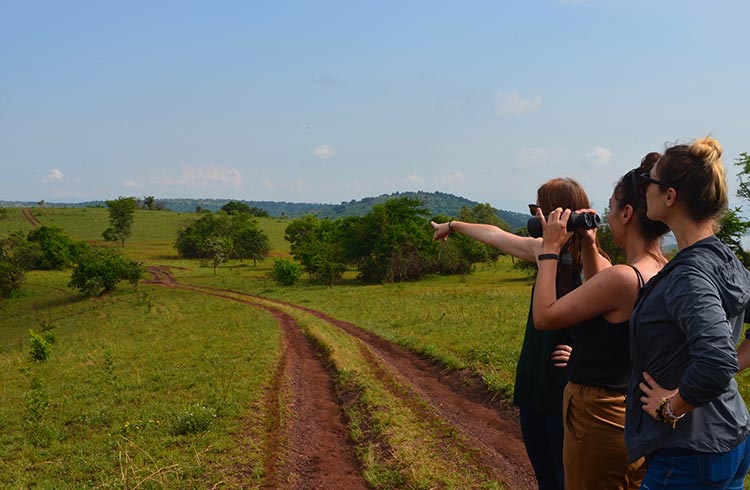 Photo © Alicia Erickson
Photo © Alicia Erickson
It’s October, and along with two friends, I head off on a weekend safari from Kigali, Rwanda’s capital, my home in 2017 and 2018. Driving in our rented 4x4, we’re ready to brave the potholed roads in Akagera National Park.
Founded in 1934 by the Belgian government, Akagera is in northeastern Rwanda, along the border with Tanzania. The park has four ecosystems: low mountains, swamps, woodlands and savannah. Once home to a diverse and abundant population of flora and fauna, much of this suffered as a result of the decline in the park’s regulation during and after the Rwandan Civil War. In the past couple of decades, however, the reintroduction of native species has made a massive difference to the repopulation of animals in the park, and the so-called “Big Five”– lions, rhinos, elephants, cape buffalo, and leopards – roam free once again.
- From Green Hills to the Savannah
- Camping in Akagera National Park
- Game Drives and Wildlife
- Trip Notes
From Green Hills to the Savannah
After navigating the roundabouts and one-way roads of Kigali, the four-hour drive east to Akagera is along a straight road that takes in Rwanda’s agricultural lands and thick forest.
We speed past blurs of terraced farms, passing young men pushing bicycles loaded high with bananas. It’s not long before rain starts pelting the car. Rain in Rwanda is never light; water cascades down the car windows, an ominous premonition for our planned weekend of camping and wildlife viewing. There’s nothing like a rainstorm to dampen the spirits of an adventure, but Rwandan rains tend to be short-lived, and the skies clear by the time we reach the park.
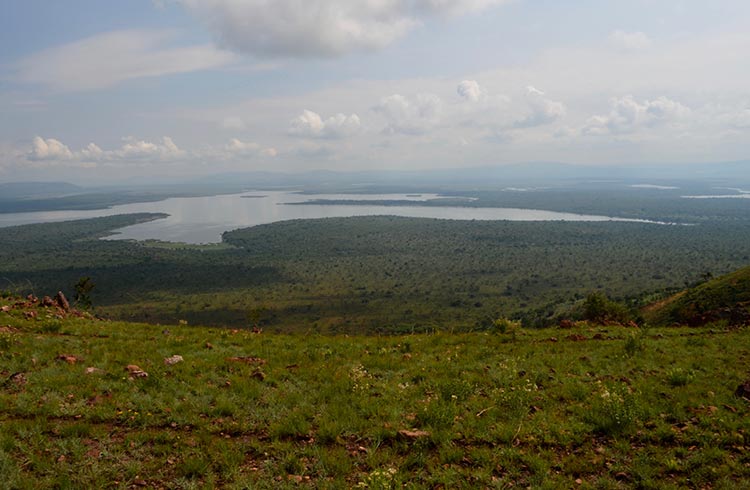
Camping in Akagera National Park
Camping is the most common form of accommodation in the national park, but there are also a handful of lodges available. We buy permits at the southern park entrance (US $25/night per person) and secure a spot at lakeside Shakani campsite for the night. It’s the only campground open in the southern sector of the park; the Mutumba Campsite is closed due to a lone, angry elephant roaming the area.
By the time we reach our camp, it’s dusk, and there’s barely enough light to set up the tent and get a fire going before darkness settles in. Shakani campsite is in an open, grassy plain on the shores of Lake Shakani, and we immediately become aware of the bird life the park is known for – more than 482 species – as vibrantly colored birds perch in the trees above.
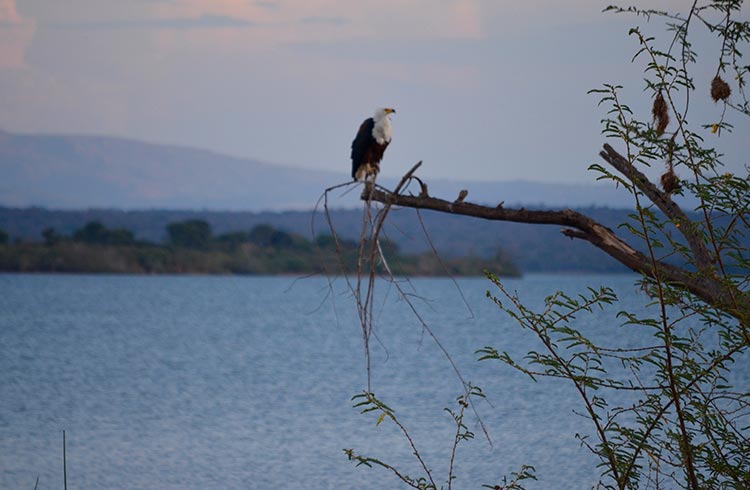
We satisfy our hunger with roasted vegetables and pasta cooked over the fire, and have the campsite entirely to ourselves. We sit around the fire sipping wine and stargazing well into the night.
Sleep doesn’t last long in the heart of the wild. We are woken by the soft songs of birds as the sun peeks above the horizon, and hear hippos splashing in the nearby lake.
Game Drives and Wildlife
Game drives are best started in the early morning, when animals are awake and active, before they escape the heat of the afternoon.
At 7am, we meet our guide at the southern entrance park reception, just a 10-minute drive from camp. Although not required, guides are a highly recommended in Akagera, as they help to navigate the confusing maze of roads and offer their superior knowledge of wildlife and park history. While it is possible to pre-book guides when you buy park permits upon arrival, it is not necessary.

It’s obvious that Emmanuel, our young Rwandan guide, has great pride in his country and a deep knowledge of the history of Akagera and Rwanda. As he drives our car around in search for wildlife, he entertains us with his gentle sense of humor, and we admire his uncanny ability to spot an animal a mile away.
Not long after we depart, the car slows to a stop.
“Look,” a smile creeps into Emmanuel’s voice as he points to a tree. Looking around for a big mammal, we soon see a bird gently perched on a branch, with turquoise and violet feathers. “You know Akagera is famous for birds? People travel here just for bird safaris.”
“Bird safaris?!” We groan. “What about the lions and elephants?” Noticing our disenchantment with bird life, he becomes determined to make us bird enthusiasts by the end of the day.
Bumping along the rust-colored roads, we head up steep hills that eventually flatten out to mountain plateaus. Emanuel takes us to a spot perfect for photos, and encourages us out of the car. He tells us this part of the park is predator-free, so we are completely safe.
“Out of the car? Where the animals are?” I’m shocked. Getting out of the car on safari–even sticking an arm out–is always a huge no-no.
Green hills span for as far as the eye can see. I walk to the mountain’s edge to peer into the valleys below, where I see thick bush and grazing antelope.
In the early afternoon, we leave the mountainous terrain and dip down into marshy swamps. Zebras cross rivers that traverse the valleys, their black and white striped bodies a striking contrast against the verdant terrain. Fields of green eventually give way to the third ecosystem: woodlands accented by burnt orange leaves, a sign of the lingering dry season waiting for impending rain.

“What do you think of my country?” Emmanuel asks. “Don’t you find it so clean and so safe?”
Emmanuel tells us about a plan he and the other guides have to open a camp outside the park for visitors to stay, where they can eat local food and learn about Rwandan culture. “I want people to know about our traditions, not just our parks.”
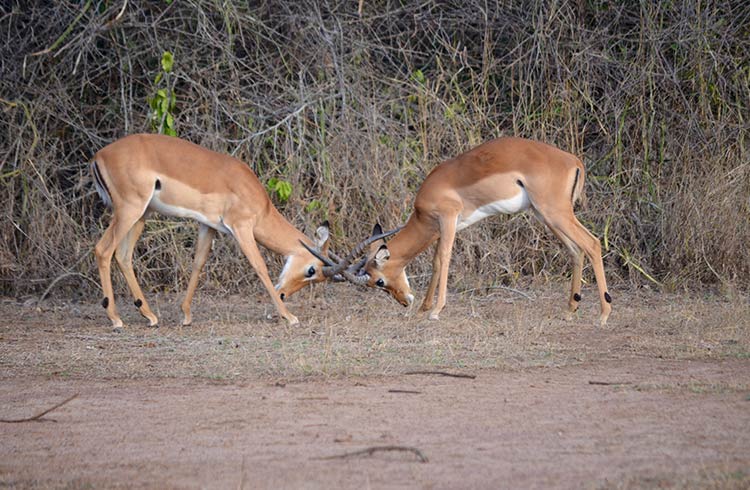
Driving on, warthogs, waterbuck, and baboons traipse across the parched plains and birds with yellow, orange and blue feathers take flight around us. We watch two young male impala butting their horns, engaged in a battle to determine the dominant male of their family, and in the thick of the meadow, two giraffes playfully fight, their necks intertwining with one another.
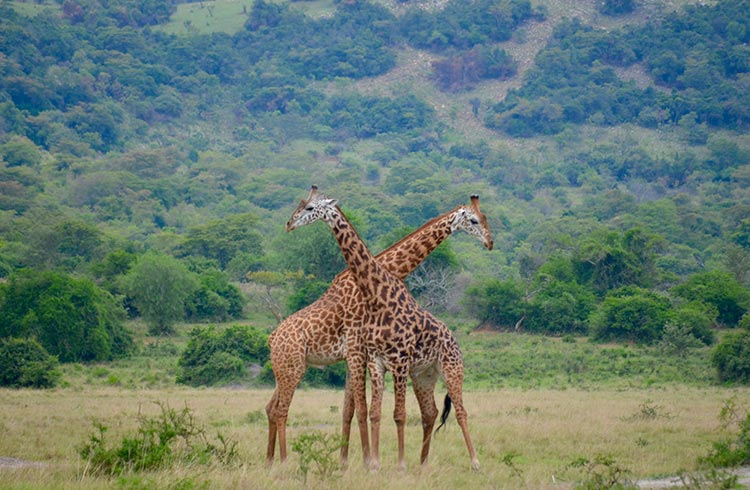
As early evening sets in, and we nearing the end of our drive, there’s a memorable highlight; we spot the king of the savannah: a male lion sleeping beneath the shade of a tree. His golden mane tousles in the wind while his eyes sleepily blink open and close. We silently gape at the mighty cat, his size almost diminished beneath the grandeur of the acacia tree.
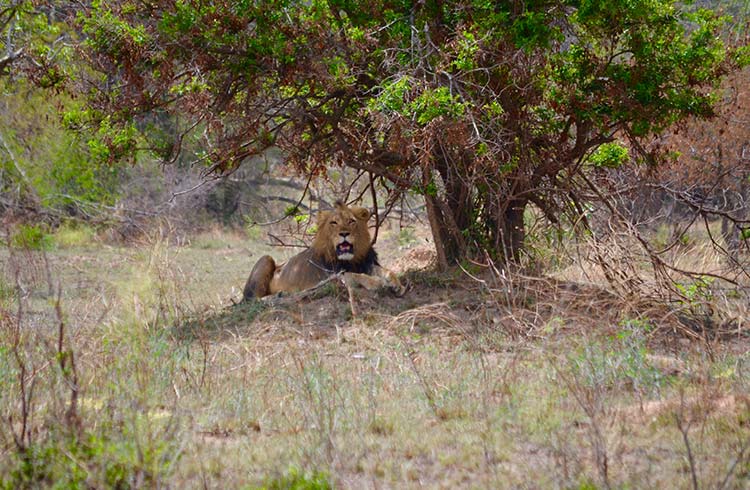
At the northern exit of the park, we join the road that leads back to Kigali. As we farewell Emmanuel, he says, “I hope you enjoyed Akagera and my country. You are welcome anytime.”
Trip Notes
Safety
Rwanda is politically stable, safe to travel in, and has minimal petty crime.
Other things to do in Akagera National Park
While game drives are the most common activity in Akagera, you can also take a boat ride on Lake Ihema, where you float down glassy water with hippos surfacing beside you, and crocodiles lingering nearby on rocks.
Campsite information
Bathrooms are provided on all campsites as well as firewood and a fire pit for campfires and cooking.
If you don’t have your own camping gear, tents can be rented at the park reception, which is located at the southern entrance to the park.
If you’re only able to stay one night, the most logical option is to camp at Shakani Campsite in the southern section of the park. If you have more time, stay the second night at Muyumbu Campsite in the north of the park.
Our guide cost US $40 for a full-day tour, or we had the option to pay US $25 for a half-day.
If you don’t want to camp, a handful of lodges are available. Ruzizi Tented Lodge offers free-standing, ensuite luxury tents hidden beneath the shade of fig trees, over-looking Lake Ihema. Rates start at US $195/ppn in low season and US $235/ppn in high season.
Best time of year to go
June-October are the driest months with prime game viewing. Avoid Rwanda’s heaviest rainy season, which is March–May, making camping and wildlife viewing a challenge.
Park fees are US $35/per day/per person, payable at the welcome center at the park entrance.
What to pack
Water and snacks, lightweight clothing and good walking shoes for the day, and layers for nighttime when temperatures drop.
Related articles
Simple and flexible travel insurance
You can buy at home or while traveling, and claim online from anywhere in the world. With 150+ adventure activities covered and 24/7 emergency assistance.
Get a quote
No Comments